Understanding and Using the "Maintenance Mode function for Main Device" Option in PTW V7.0.
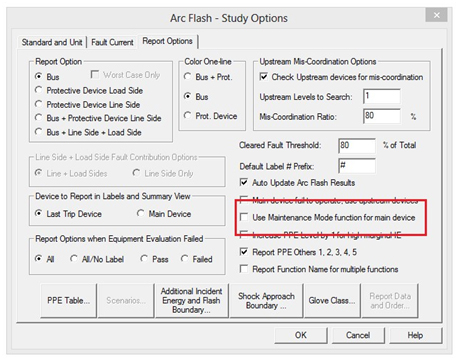
Arc flash incident energy mitigation is an important part of an arc flash hazard analysis. Once the incident energies are calculated, locations with high incident energies (normally ≥ 8 cal/cm2) could be identified.
The high incident energies identified at these locations, could be mitigated using many methods and technologies. The preferred method is to change the settings of existing circuit breakers so the arcing current will be cleared faster without any costly changes. But these setting changes could - and normally do - upset the coordination of the system making it more susceptible to partial or total blackouts. A new technology called "arc flash reduction maintenance system (ARMS)" allows a reasonable compromise between safety and continuity of service.
The ARMS device is normally a specialized circuit breaker with two independent functions. One function (normally named "phase") is selected when the system is in normal operation. The other function (normally assigned the named "ARMS") is activated ONLY when performing energized work on the protected equipment. Both functions (phase and ARMS) can't be active at the same time.
In the phase (normal) function, the settings of the ARMS device are chosen for protection and coordination of the electrical system during normal operations. In the ARMS (maintenance) function, the settings of the ARMS device are chosen to have a very fast response (no intentional delay) to the expected arcing current (not the available short circuit current). This fast response substantially diminishes the trip time and therefore the incident energy at the protected equipment.
The drawback for this gain in safety is the loss of coordination while the ARMS function is active.
It is important that the ARMS device should be located one level upstream from the equipment to be protected. For example, if the equipment to be protected is a power panel (with or without a main overcurrent protection device), the ARMS device should be installed in the upstream feeder panel. It is not recommended to install the ARMS device as the main overcurrent protection device at the protected power panel. See Figure 1.
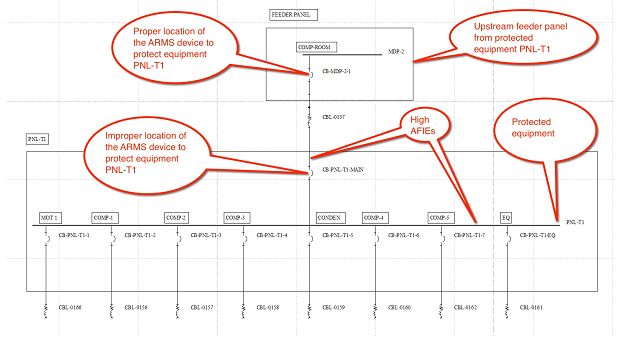
If the ARMS device is installed as the main overcurrent protection device, the load-side incident energy will be substantially reduced, but the more dangerous line-side AFIE will not be affected. In contrast, when the ARMS circuit breaker is installed in a separate enclosure, upstream from the equipment to be protected, the line-side and load-side incident energies are reduced.
To use the ARMS option in the Arc Flash module, you have to add an ARMS function to the circuit breaker to the already existing phase function. The scope of this article does not cover how to add this new function. We assume in this paper that the ARMS function already exists.
Since the ARMS device has two functions (each with its own settings), the Arc Flash module in SKM needs to know which of the two functions is active before running the study. To do so, you have two options.
First option: Enter the component editor of the ARMS device (the Protective Device subview), then click on the Function button. This opens the Protection Functions screen. Now check the Use in Arc Flash check box corresponding to the ARMS function. Then click on the OK button. This will take you back to the Component Editor subview. Verify that the ARMS function name is shown to the left of the Toggle button. See sequence of Figure 2A and Figure 2B.
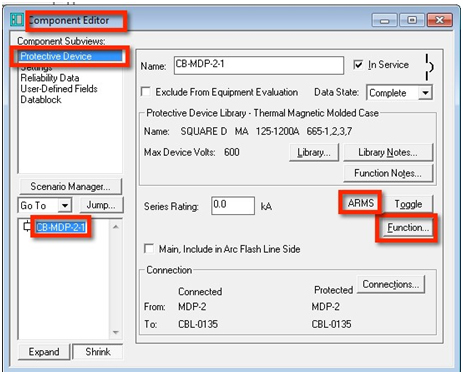
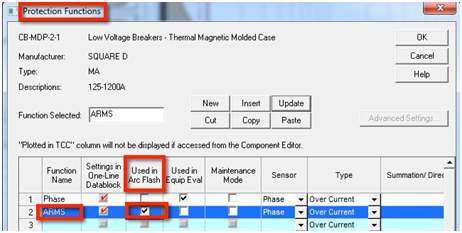
Note that from this moment on, all arc flash calculations will be based on the ARMS function settings. If you want to calculate the incident energy using the normal phase function settings, it will be necessary to revert his procedure. This is a tedious process.
Second Option: Activate the Use Maintenance Mode function for Main Device. When this option is activated in the Arc Flash - Study Options (Report Options tab) screen, the arc flash study will use the maintenance function settings if the checkbox Maintenance Mode in the Protection Function screen is checked for the ARMS device. See Figure 3. Therefore, when you create this ARMS function in your ARMS device, make sure that this checkbox is checked.
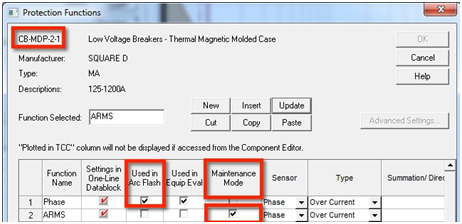
If you want to calculate the incident energies without the ARMS maintenance function settings active
(i.e. calculate using the phase or normal settings), uncheck the Use Maintenance Mode function for Main Device check box from the Arc Flash - Study Options screen on the Report Options tab. This procedure is much simpler than going to the Component Editor of the overcurrent protection device, then to the Protection Function screen and finally unchecking the Used in Arc Flash checkbox for the ARMS function and checking the Used in Arc Flash checkbox for the Phase function.